|
Secrets of
the Valley of the Kings
Zahi Hawass
It is the dream of every archaeologist to dig in the Valley of the Kings,
the burial ground of the monarchs of the New Kingdom (ca. 1500-1100 BC).
Of all the sites in Egypt, this is one of the most magical. It is hard to
believe that, of the 63 tombs found in the valley, not one was officially
discovered by an Egyptian archaeologist.

For the last two centuries, the valley has been explored by adventurers
and tomb robbers as well as archaeologists. The most exciting discovery
here, indeed the most fabulous find in the history of Egyptology, was made
on November 4, 1922, when British excavator Howard Carter found the intact
tomb of Tutankhamun (known as KV 62). The story of this great find, and
the magnificent objects that were recovered (over 5,000 of them) still
captures the hearts of the world, and overshadows many of the other
important discoveries that have been made in the Valley, such as the
mostly-intact tomb of Yuya and Tjuya, who were probably the
great-grandparents of King Tut, and the tomb of Amenhotep II.
When I was young, I went to work on the West Bank at Thebes, where the
Valley of the Kings is located, with the University of Pennsylvania-Yale
Expedition to Malkata. Malkata is the site of the palace of Amenhotep III,
the grandfather of Tut. It lies in the floodplain south and east of the
royal Valley. I was one of over 30 young Egyptian archaeologists working
with foreign expeditions in the area. This was during the 1973 war, and we
were not allowing foreign archaeologists to work at any other sites, so
many of us were was gathered at Thebes.
My colleagues and I used to meet in the afternoon at El Marsam Hotel,
owned by a man named Shiekh Ali Abdel Rassoul, the last surviving member
of the Abdel Rassoul family. In the 19th and early 20th century, the Abdel
Rassouls were known as the most successful tomb robbers in the area. In
1871 (or perhaps before), they had stumbled across a deep shaft that led
to a series of corridors containing the mummies of many of the kings and
queens of the New Kingdom. The royal mummies had been hidden in this
secret cache during the Third Intermediate Period, when the central
government could no longer guard the Valley of the Kings. The family kept
the find hidden for ten years, until the Antiquities Service tracked them
down and forced them to reveal their secret. The Abdel Rassouls had also
led Victor Loret, then head of the Egyptian Antiquities Service, to the
Bab el-Gasus, a tomb containing over 150 mummies and coffins from the
Third Intermediate Period, and to the tomb of Amenhotep II in the Valley
of the Kings, where more royal mummies had been cached in ancient times.
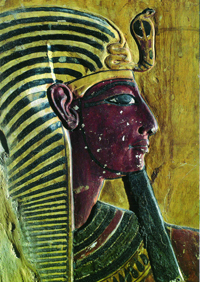
The Tunnel in the Tomb of Seti I
My friends and I used
to sit with Sheikh Ali at night, laughing and playing games. But the
Sheikh felt that I was different from the others, and he would
single me out. We spent a lot of time talking, just the two of us,
about many different things. One day he asked me to go with him to
the Valley of the Kings, into the burial chamber of the tomb of Seti
I. |
He pointed out the entrance
to a roughly-cut tunnel, which he told me descended for about 100 meters
(300 feet) and ended in the secret burial chamber of Seti I.
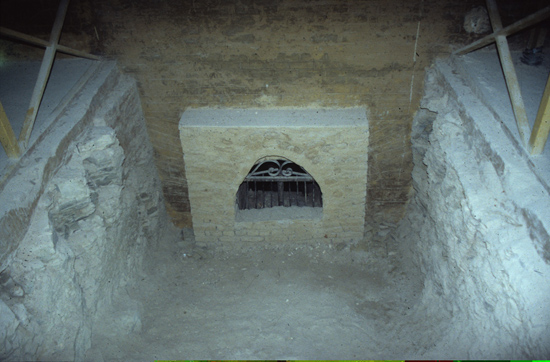
I found out later that
although there certainly is a long tunnel, Seti I’s real burial cannot be
hidden at the end, as he was clearly buried in the main part of the tomb.
The king’s massive alabaster sarcophagus was found in the burial chamber
tomb by Italian adventurer Giovanni Belzoni in 1817.
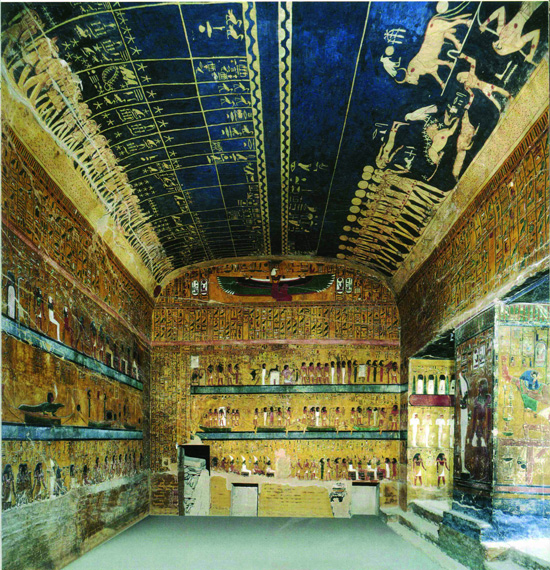
He took this to England, and
it is now displayed in the Sir John Soane Museum in London. More important
is the fact the Seti I’s mummy was found in the first royal mummy cache,
the one found by the Abdel Rassouls in 1871. But Sheikh Ali told me that
one day I would become an important archaeologist, and it would be my
destiny to explore this mysterious tunnel.
None of the other tombs in the Valley of the Kings has such a tunnel, and
Egyptologists have not been able to explain exactly what it is or why it
is there. Some have suggested that it is symbolic, and leads down into the
underworld, where the king’s soul would join with the ruler of the dead
Osiris so that he could be resurrected. But why is he the only king to
have this? How do we know that this is really what it means?
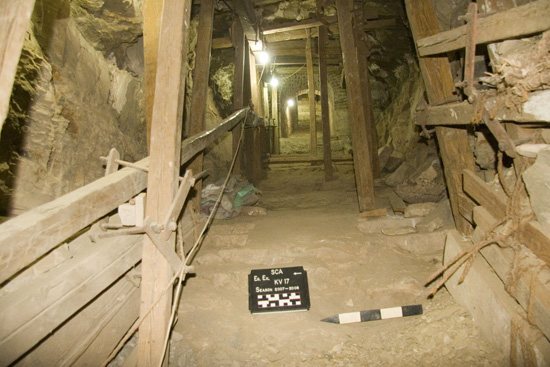
When I became
the head of the Supreme Council of Antiquities, I decided that I wanted to
explore this tunnel. In 2003, I entered the tunnel for the first time. I
attached myself to a thick rope for safety, and a light was set up so that
I could see.

I wore my famous hat, and
took a measuring tape with me. I descended along a gentle slope, but at
the 252-foot mark, I decided it was too dangerous to continue. Rock was
falling, and the tunnel was clearly unstable. It was also becoming
narrower, and I knew that we would have to do serious work to make the
tunnel safe before we could explore further.

I entered for a second time
as part of a program made by David Jackson of KCBS in Los Angeles about
Tutankhamun and the Valley of the Kings.

Just this year, I decided to
make Sheikh Ali’s dream come true. As part of the first truly Egyptian
archaeological project in the Valley of the Kings, we are now doing a
scientific study of the tunnel. A geological survey has been carried out,
and we have begun clearance, working slowly to guarantee the safety of my
all-Egyptian team. This team, which works under my supervision, is headed
by Dr. Tarek El Awady. To date, we have cleared about 40 meters (120 feet)
of the tunnel. The results are intriguing: among the finds are a number of
non-royal New Kingdom shabtis, dating to near the reign of Seti I. I hope
that by the end of 2008 we will be able to reveal the final mysteries of
the tomb of Seti I, the most beautiful tomb in the valley.
The Tomb
of Ramesses VIII?
In 1974, during my second season in Thebes, I spent a magical night in the
Valley of the Kings. It was during the summer, and there was a full moon.
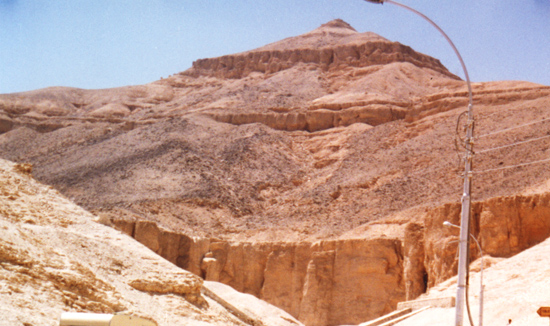
I asked Sheikh Nagdy, the
chief of the guards on the West Bank, to accompany me to climb the Qurn,
the pyramidal peak that stands sentinel over the Valley. Sheikh Nagdy was
the son of Sheikh Abdel Maugoud, who had known Howard Carter personally.
Sheikh Maugoud told me once that he had seen Evelyn Herbert, the daughter
of Lord Carnarvon, enter the tomb of Tutankhamun at night several times.
He believed that Howard Carter was in love with her, not, as many people
think, that she was in love with him but he was indifferent. When I
climbed the Qurn that night, I felt magic in the silence that surrounded
me.
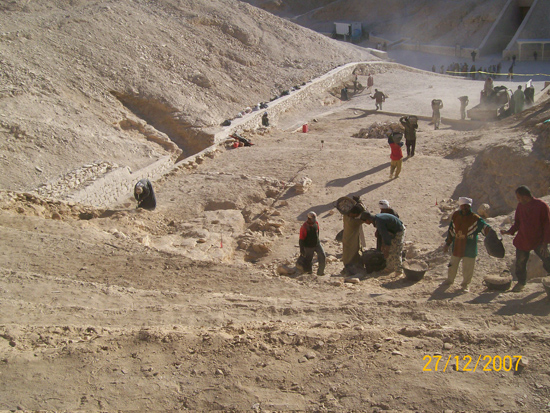
Later, I became interested in pyramids and spent most of my life
excavating around them. But my eyes would always turn again to the Valley
of the Kings. A few years ago, there was an English expedition working in
the Valley, looking for the lost tomb of Nefertiti. They used radar to see
what might be hidden below the ground, and found an “anomaly” that they
tentatively identified as KV 64, an unknown tomb. This anomaly is very
interesting, and the area should be explored some day, but right now we
are working in a different area of the Valley. We are hoping to find the
tomb of Ramesses VIII, which has never been discovered, somewhere between
the tomb of Merenptah (KV 8), son and successor of Ramesses II, and the
tomb of Ramesses II himself (KV 7).
The team that I have
appointed to search for the tomb of Ramesses VIII is headed by Afifi
Rohiem, who has worked with me for many years at Giza. We began our work
to the north, south, and west of the tomb of Merenptah. We have
rediscovered ancient graffiti recorded by the great scholar Jaroslav
Czerny. One of these was written by the 18th Dynasty vizier Userhat, who
says that he built a tomb for his father, Amennakht, in this area. The
site is littered with large blocks, which we are moving in our search for
lost tombs – and we are finding tantalizing clues that something is hidden
here. In the area to the south of Merenptah’s tomb, we found a cutting in
the bedrock, but the rubble at the entrance to whatever lies beyond has
been disturbed. If there is a tomb here, it is unlikely to be intact.
However, another cutting, to the north, appears to be undisturbed. We have
also found workmen’s huts, which we have recorded carefully. We are
planning to bring in very sophisticated radar that can see 20 meters down,
and hope that this will help guide us in our work.
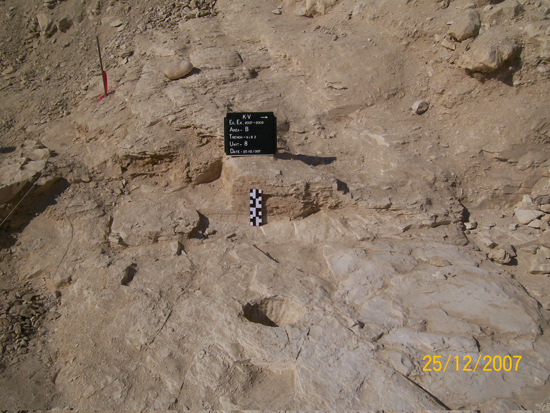
There are many secrets still hidden in Valley of the Kings, and on the
West Bank of Luxor. The real tomb of Amenhotep I is still being debated.
Some scholars believe that he was buried in KV 39 (in the Valley of the
Kings), and others believe that his tomb is at Dra Abu el-Naga, at the
northern end of the Theban necropolis. Now a Polish archaeologist is
exploring his theory that the tomb is hidden in the rocky cliffs behind
the temple of Hatshepsut at Deir el-Bahari, and, although the king’s mummy
and coffin were found in the first royal mummy cache, he dreams that it is
still intact. The tomb of Thutmose II is also still not definitely
identified. Was he buried in KV 42, or DB 358, or is his tomb still
unknown? (Again, it is unlikely to be intact, since his body was in the
first royal mummy cache.) Where is the Amarna royal family: Akhenaten
(whose body may be the one that was found in KV55), the elusive Smekhkare,
Nefertiti, and their princesses? There are many other queens of the New
Kingdom whose burials have not yet been found; any of these, if found
intact, are sure to be absolutely spectacular; if robbed, they would still
be fantastic. As I always say, you never know what secrets are hidden
beneath the sand of Egypt.
BACK
to The Plateau Homepage |










